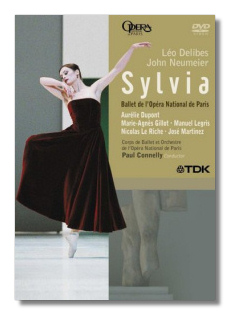
The Internet's Premier Classical Music Source
Related Links
- Latest Reviews
- More Reviews
-
By Composer
-
Collections
DVD & Blu-ray
Books
Concert Reviews
Articles/Interviews
Software
Audio
Search Amazon
Recommended Links
Site News
 DVD Review
DVD Review
Léo Delibes

Sylvia
- Aurélie Dupont (Sylvia)
- Manuel Legris (Aminta)
- Nicolas Le Riche (Amour/Orion)
- Marie-Agnès Gillot (Diana)
- José Martinez (Endymion)
Orchestre et Corps de Ballet de l'Opéra National de Paris/Paul Connelly
TDK DVWW-BLSVA DVD 139min Anamorphic Widescreen
Even if you know this ballet, you are well advised to read the synopsis included in the booklet, and to watch the bonus documentary featuring an interview with choreographer John Neumeier. Indeed, this Sylvia is not "self-explanatory." It is, however, fascinating, and it will give even the most jaded balletomane something to chew on. (Admittedly, some will spit it out!)
Neumeier has dispensed with the fussy mythological libretto by Jules Barbier and Baron de Reinach and has come up with a story at once simpler and more ambiguous. What if Sylvia, a sort of proto-Amazon devoted to Diana, discovers the possibility of love with the shepherd Aminta, but is forced to reject him in favor of ambition and career? In the second part of the ballet they meet again, dressed not as a huntress and a shepherd but in elegant evening wear. This time, Sylvia's head is turned not by ambition but by pleasure, and by the erotic attention paid to her by a swarm of young men in tuxedos. (Shades of Marilyn Monroe in Gentlemen Prefer Blondes!) In the final part of the ballet, Sylvia and Aminta, now grown older, return the site of their first meeting. An awkward attempt to rekindle an old flame sputters out, and Sylvia, valise in hand, is ushered away by an older gentleman. Aminta once again experiences disappointment. As for Diana, "she remains alone, the eternal huntress." Neumeier has cut or reordered some numbers, and interpolated others from La Source. Still, all the favorites are here, but not as Delibes and his collaborators envisioned them in 1876. (For example, the "Pas de Éthiopiens" has been turned into an elegant but also almost grotesquely swaggering mating dance for a group of men in evening wear.)
In terms of choreography, the conventions of classical ballet have been turned on their ear in this production. For example, men only partner women, but each other, and when they lift a woman, they are not unlikely to whip her around like a wet gym towel before setting her down again. Yes, there is dancing en pointe, but Neumeier is enamored with eccentric gestures and with what might be called the poetry of awkwardness. Also, he is unafraid to take the rarefied emotions of classical ballet and to make them hotly physical and immediate. Without putting too fine a point on it, this is a carnal Sylvia, a characteristic not weakened by the preponderance of bare skin and by the exceptional physical beauty of many of the dancers – not just their bodies but also their expressive faces. Among the five star dancers, it is hard to choose favorites, but the remarkable Aurélie Dupont burns like ice in the title role, and as Amour (in red overalls and a backwards-turned baseball cap!) and Orion, Nicolas Le Riche combines the most buoyant athleticism with an appealing, mischievous humor. Neumeier gives the corps de ballet plenty to do, and its men in particular are challenged almost as much as the three danseurs etoiles. They rise to the challenge beautifully. Paul Connelly and the orchestra are first-class in providing the dancers with infectiously sprung rhythms and lush, melting melody. Heard but not seen, Delibes score has its longueurs, but when accompanied by dancing of this caliber, it seems not a moment too long.
This production was filmed live in March 2005 in Paris. The visuals (Anamorphic Widescreen) are ideally crisp, as is the sound, which is in the three standard formats. Rather than between numbers, the layer charge comes in the middle of one, and this is briefly distracting, however. The bonus documentary accounts for 19 minutes of the total playing time, and is subtitled in several languages. As I mentioned at the start of this review, it should be watched first, not after.
Unless you're looking for a classical Sylvia, Neumeier's production should give you plenty of enjoyment, and it stands up well to repeated viewing.
Copyright © 2006, Raymond Tuttle




















